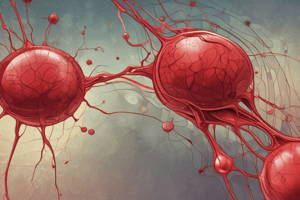Podcast
Questions and Answers
What is the most appropriate therapeutic management for Henoch-Schönlein purpura?
What is the most appropriate therapeutic management for Henoch-Schönlein purpura?
- Antibiotics
- Splenectomy
- Oral corticosteroid therapy (correct)
- Platelet transfusion
Which age group is most commonly affected by Henoch-Schönlein purpura?
Which age group is most commonly affected by Henoch-Schönlein purpura?
- Elderly
- Children between 2 and 8 years (correct)
- Teenagers
- Infants
What is a common presenting symptom of Henoch-Schönlein purpura?
What is a common presenting symptom of Henoch-Schönlein purpura?
- Hypertension
- Gastrointestinal symptoms (correct)
- Seizures
- Respiratory distress
What is the cause of Hemophilia A (Factor VIII Deficiency)?
What is the cause of Hemophilia A (Factor VIII Deficiency)?
What treatment is typically used for Hemophilias?
What treatment is typically used for Hemophilias?
What might be seen in a biopsy of a child with Henoch-Schönlein purpura?
What might be seen in a biopsy of a child with Henoch-Schönlein purpura?
What is the normal platelet level in the blood?
What is the normal platelet level in the blood?
What platelet count defines thrombocytopenia?
What platelet count defines thrombocytopenia?
What is the main cause of Idiopathic Thrombocytopenic Purpura (ITP)?
What is the main cause of Idiopathic Thrombocytopenic Purpura (ITP)?
Which condition may present with miniature petechiae or asymmetric ecchymosis over the legs?
Which condition may present with miniature petechiae or asymmetric ecchymosis over the legs?
What is a common consequence of Thrombocytopenia?
What is a common consequence of Thrombocytopenia?
What syndrome involves thrombocytopenia and absence of the radius bone in the forearm?
What syndrome involves thrombocytopenia and absence of the radius bone in the forearm?
Study Notes
Thrombocytopenia and Purpura
- Platelet count can be as low as 20,000/mm3
- Bone marrow examination shows a normal number of megakaryocytes
Henoch-Schönlein Syndrome
- Caused by increased vessel permeability, leading to bleeding in small blood vessels
- Occurs most frequently in children between 2 and 8 years old
- More frequent in boys than girls
- Usually, there is a history of a mild infection before the outbreak of symptoms
- Presents as a possible platelet disorder until a differential diagnosis is made
- Assessment:
- Purpural rash on buttocks, posterior thighs, and extensor surface of arms and legs
- Rash begins as urticarial lesions that change to pink maculopapules
- Joint tenderness and swelling
- Gastrointestinal symptoms
- Gross or microscopic hematuria may be present
- Biopsy shows granulocytes in small arteriole walls
- Therapeutic management:
- Oral corticosteroid therapy (prednisone)
- Mild analgesics for a short period
- Nose and throat cultures to rule out bacterial involvement
- Urine assessment for protein and glucose to detect kidney involvement
- Disease typically runs a course of 4 to 6 weeks
- Complication: mild chronic nephritis
Hemophilias
- Inherited disorders of blood coagulation
- Types: each involving a deficiency of a different blood coagulation factor
- Hemophilia A (Factor VIII Deficiency):
- Caused by deficiency of the coagulation component factor VIII
- Transmitted as a sex-linked recessive trait
- Factor VIII is an intrinsic factor of coagulation
Disorders of Blood Coagulation
- Platelets are necessary for blood coagulation
- Disorders that limit the number of platelets limit the effectiveness of this process
- Normal platelet level: 150,000/mm3
- Thrombocytopenia (decreased platelet count): less than 40,000/mm3
- Thrombocytopenia often leads to purpura or blood seeping from vessels into the skin
Purpuras
- Refers to a hemorrhagic rash or small hemorrhages in the superficial layer of skin
- Two main types: idiopathic thrombocytopenic purpura and Henoch-Schönlein syndrome
Idiopathic Thrombocytopenic Purpura
- Result of a decrease in the number of circulating platelets in the presence of adequate megakaryocytes
- Cause is unknown, but thought to result from an increased rate of platelet destruction due to an antiplatelet antibody
- Assessment:
- Manifestations often begin abruptly
- Miniature petechiae or large areas of asymmetric ecchymosis
- Epistaxis or bleeding into joints may be present
- Laboratory studies reveal marked thrombocytopenia
Studying That Suits You
Use AI to generate personalized quizzes and flashcards to suit your learning preferences.
Description
This quiz covers disorders related to blood coagulation, with a focus on thrombocytopenia which is characterized by decreased platelet count. Learn about the symptoms and implications of thrombocytopenia, as well as related complications. Explore how platelet levels affect the blood coagulation process.



